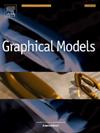Disambiguating flat spots in discrete scalar fields
IF 2.2
4区 计算机科学
Q2 COMPUTER SCIENCE, SOFTWARE ENGINEERING
引用次数: 0
Abstract
We consider 2D scalar fields sampled on a regular grid. When the gradient is low relative to the resolution of the dataset’s range, the signal may contain flat spots: connected areas where all points share the same value. Flat spots hinder certain analyses, such as topological characterization or drainage network computations. We present an algorithm to determine a symbolic slope inside flat spots and consistently place a minimal set of critical points, in a way that is less biased than state-of-the-art methods. We present experimental results on both synthetic and real data, demonstrating how our method provides a more plausible positioning of critical points and a better recovery of the Morse–Smale complex.

离散标量场中的平点消歧
我们考虑在规则网格上采样的二维标量场。当梯度相对于数据集范围的分辨率较低时,信号可能包含平坦点:所有点共享相同值的连接区域。平坦点阻碍了某些分析,如拓扑表征或排水网络计算。我们提出了一种算法来确定平面点内的符号斜率,并始终如一地放置最小临界点集,以一种比最先进的方法更少偏见的方式。我们给出了合成和真实数据的实验结果,证明了我们的方法如何提供更合理的临界点定位和更好的莫尔斯-斯莫尔复合物的恢复。
本文章由计算机程序翻译,如有差异,请以英文原文为准。
求助全文
约1分钟内获得全文
求助全文
来源期刊

Graphical Models
工程技术-计算机:软件工程
CiteScore
3.60
自引率
5.90%
发文量
15
审稿时长
47 days
期刊介绍:
Graphical Models is recognized internationally as a highly rated, top tier journal and is focused on the creation, geometric processing, animation, and visualization of graphical models and on their applications in engineering, science, culture, and entertainment. GMOD provides its readers with thoroughly reviewed and carefully selected papers that disseminate exciting innovations, that teach rigorous theoretical foundations, that propose robust and efficient solutions, or that describe ambitious systems or applications in a variety of topics.
We invite papers in five categories: research (contributions of novel theoretical or practical approaches or solutions), survey (opinionated views of the state-of-the-art and challenges in a specific topic), system (the architecture and implementation details of an innovative architecture for a complete system that supports model/animation design, acquisition, analysis, visualization?), application (description of a novel application of know techniques and evaluation of its impact), or lecture (an elegant and inspiring perspective on previously published results that clarifies them and teaches them in a new way).
GMOD offers its authors an accelerated review, feedback from experts in the field, immediate online publication of accepted papers, no restriction on color and length (when justified by the content) in the online version, and a broad promotion of published papers. A prestigious group of editors selected from among the premier international researchers in their fields oversees the review process.
 求助内容:
求助内容: 应助结果提醒方式:
应助结果提醒方式:


